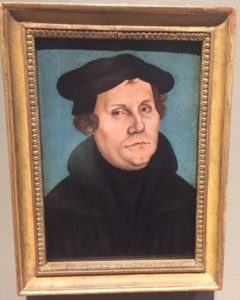Martin Luther & His 95 Theses That Transformed the Church
Celebrating the Reformation’s 500th Anniversary

To mark the 500th anniversary of Martin Luther’s Ninety-Five Theses, and the launch of the Protestant Reformation, the Minneapolis Institute of Art just wrapped up its popular exhibition “Martin Luther: Art and the Reformation.” Many of the works of art and personal artifacts had never before left Germany, and it was a special exhibition for Protestant Christians in Minnesota.
As we celebrate the Quincentenary of the Reformation, we encourage all evangelical Christians to reflect on the breadth of reforms in Christian teaching and practices that followed Luther’s bold actions.
“As we celebrate the 500th anniversary of the Reformation, I hope we will make this a ‘year of grace’ and deepen our understanding of God’s amazing love for us and the gracious initiative that God took to forgive our sins,” said Carl Nelson, president of Transform Minnesota.
[pullquote style=”left” quote=”dark”]I hope we will make this a ‘year of grace’[/pullquote] In case you missed the MIA’s exhibition “Martin Luther: Art and the Reformation,” we’ve compiled this resource on the Reformation including many of the curators quotes as well as photos of the artifacts and artwork from the exhibition.Justification through Grace Alone
“Saved by the grace of God.” Some variant of this statement can be found in most evangelical churches’ statement of beliefs, and we have Luther to thank for laying this truth out so clearly.

Luther’s theology of ‘justification through faith’ puts mercy back into God’s hands alone, not the Popes.
“The doctrine of grace, as Luther stated it, is that we cannot create our own faith or earn our own relationship with God. Rather, it is God who takes the first step towards us, and God who justifies us so that we can have relationship with him,” said Nelson.
“When you read Martin Luther, you realize he was frightened and he really believes that there was God’s love out there, and he thought that the Catholic Churches he saw, was not only not helping people, it was stopping people from believing. And that’s why he got up and whacked that thesis on the door, and said, “No, it’s not working,” said Professor Louis Nebelsick, German Office for Heritage Management and Archaeology Saxony-Anhalt.
Luther’s Narrow Intent had Explosive Results

“(Luther believes) indulgences led people down the wrong path. He felt they were being deluded. They were wasting their money. They came to think that they could buy God’s mercy. They came to think that the Church controlled God’s mercy. Luther thought the Church announces God’s mercy; it does not control God’s mercy,” said Dr. Mary Jane Haemig, ThD, Professor of Church History and Director of the Reformation Research Program at Luther Seminary.
Luther soon found himself leading a movement to reform the way Christians viewed salvation, scripture, and their relationship with God.
“The Luther Exhibit at MIA open my eyes to the incredible historical impact that Luther had. What began as theological dialogue when he nailed the 95 theses on the door quickly grew into division and conflict within the church, which led to political conflict and very unfortunately many years of war and fighting,” said Nelson.
Luther’s theses have modern-day ramifications in how Christians personally accepted their own salvation, their relationship and right-standing with God, and decreased their dependence on the larger Church to teach the Word of God. [pullquote style=”right” quote=”dark”]The Reformation was a necessary theological correction…[/pullquote]

Whether Luther wanted to or not, he was soon leading a religious revolution. When his proposed reforms of the Catholic Church were met with heated conflict, he and his followers broke away to form a new church, eventually resulting in Lutheranism and a variety of Protestant denominations.
“After Luther, Western Europe was no longer uniformly under Rome but rather saw a variety of Christian expressions,” said Professor Mary Jane Haemig.
“The Reformation was a necessary theological correction, but it also unleashed a pattern of Christians separating themselves over theological disagreement, and I believe we need to be extremely cautious about dividing the Body of Christ. A value to guide us is ‘In essentials unity, in non-essentials liberty, and in all things charity,’” said Nelson.
The Word of God Accessible to All
Martin Luther believed that the Bible was the only authoritative word of God. In studying the New Testament he concluded that each Christian was responsible for his or her own faith. For Luther this meant that every Christian needed a Bible in an accessible language. One of Luther’s greatest missions became to translate the Bible into German.

“Luther’s theology was centered around the Word, the Word alone, the Word of God,” said Tom Rassieur, Curator, Prints and Drawings, Minneapolis Institute of Art.
Luther spent much of his time at the Wartburg Castle working on a translation of the New Testament of the Bible, translating it from the original Greek to German. His hope was to get the vernacular Bible into the hands of Christians to read on their own.
“Luther and his fellow reformers knew how to use the printing press. It was the whole matter of writing in German that put him ahead. And so he could turn out short pamphlets, like the sermon on indulgences and grace, or some other sermons which may not have been preached, but they were short messages. The people who read his message often would read it aloud to others, people who couldn’t read, or they would absorb it and convey it in their own way,” said Dr. Mary Jane Haemig.
[pullquote style=”left” quote=”dark”]Luther’s theology was centered around the Word, the Word alone…[/pullquote] The portrait of Martin Luther 1521 by Hans Baldung Grien helps portrays Luther’s passion for the Word of God; in it he’s depicted as a saint, with his hands symbolically resting on the Bible.“Not only is Luther divinely inspired from above by the Holy Spirit, but also from scripture. It’s a reminder of Luther’s teachings and adherence to “Sola Scriptura,” his belief that scripture was the sole authority for Christians,” said Joanna Lindell, Curator, Thrivent Financial Collection of Religious Art.
The Model of Family Life
One of the big revolutions of Martin Luther’s Protestantism was he had been married. This changed the whole system in which the Church was previously supposed to be the center of a priest’s life, now Luther modeled the importance of his tri-roles as pastor, husband and father.

“He and his wife (Katharina von Bora) would become paradigms of moral behavior. The priests weren’t allowed to have kids and have a family because this would have destroyed the unity of the Church. It was Martin Luther who said, ‘No, it’s going to be the Pastor and the Pastor’s wife who are going to be like the familial center of the Church.’ And so they were living the model family live,” said Professor Louis Nebelsick.
His expression of greatest respect and admiration for his wife, Katharina is evident in Luther’s last will and testament. He called Katharina, the women who had “held him dear, worthy, and fine as his devout and faithful marital spouse throughout his lifetime.” In a rare legal move, Luther made Katharina sole heir to his entire property, and sole legal guardian of their children.
Celebrating the Reformation
Many of the beliefs and practices evangelicals revere in worship and prayer are a direct result of the Spirit-inspired revisions Martin Luther brought before the Roman Catholic Church in 1517.
Luther and the Reformation brought about a new age of discovering one’s personal faith, a sense of gratitude for the free gift of God’s grace, and an emphasis on the important practice of consulting the Bible yourself. These are lasting lessons that continue to impact the Christian church in the present day.
“Another lesson we can learn from the Reformation is that just as faith and doctrine had serious consequences in Luther’s time, what people believe and the freedom of religion will forever be of great importance,” said Nelson.
The 500th anniversary of the Reformation will be observed around the world on October 31, 2017.

